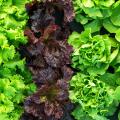Watermelons
Watermelons

Most watermelon plants require a lot of space and quickly take over a small garden. Some varieties are described as having short vines. Those described as having bush-type plants may be disappointing.
Varieties are available that produce large or small, round or oblong, solid or striped fruit with red or yellow flesh, with seeds or seedless.
Plant when the soil is warm and all danger of frost has passed. Watermelon transplants in peat cups or plastic trays can be used, but they must be small (not yet vining) to avoid plant injury. Use transplants with seedless melons because the seed is small, expensive, and slow to germinate. For seedless melon transplants, plant the seeds with the rounded end down and the pointed end up.
Hot kaps, black plastic mulch, floating row covers, and plastic tunnels are ways to obtain earliness. Black plastic also controls weeds. You can use transplants or seeds in combination with black plastic mulch. With normal vining melons, plant several seeds in groups spaced about 6 feet apart. Thin seedlings to two plants in each group. With seedless melons, it is necessary to plant some standard melons close by to provide pollination. All watermelons are pollinated by bees and require about 45 days from pollination to maturity.
Disease problems are anthracnose, fusarium wilt, gummy stem blight, and bacterial wilt. Insect problems are striped and spotted cucumber beetles.
Varieties
- Bush Charleston Gray—bush-type plant; 10- to 13-pound melons; red flesh.
- Bush Jubilee—bush-type plant; 10- to 13-pound oblong fruit; red flesh.
- Charleston Gray—30 pounds; oblong; light green; bright red flesh and dark seeds; some disease resistance.
- Crimson Sweet—23 to 30 pounds; semi-round; distinct striping; thick, hard rind; sweet, red flesh; some disease resistance.
- Jubilee—25 to 40 pounds; long; light green with dark stripes; red flesh with black seeds; some disease resistance.
- Jubilee II—22 to 30 pounds; oblong; light green with dark green stripes; open-pollinated; firm, red flesh; sweet; some disease resistance.
- Royal Jubilee—hybrid Jubilee type; elongated; 25 to 30 pounds; bright red flesh; resistant to fusarium and anthracnose.
- Royal Sweet—20 to 25 pounds; hybrid; oblong; medium-green stripes; bright red flesh and small dark seeds; some disease resistance.
Publications
News
If you grow your own vegetables, you will likely see at least a few pesky insects that want to feed on your plants. Slugs are one of the pests you may be noticing now.
Did you know yellow squash is in the pumpkin family and are 95 percent water?
Tomatoes are a popular crop, both for commercial growers and home gardeners. Even the best tomato growers run into problems along the way! We put together a simple, easy-to-follow guide to help you spot a few of the most common tomato troubles gardeners see.




